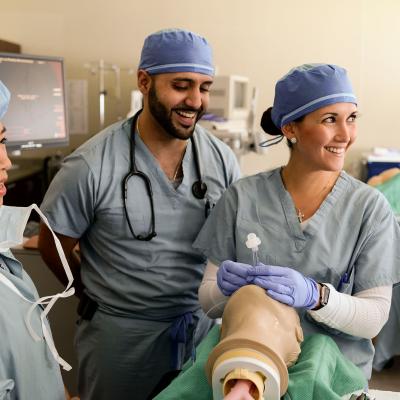- AdventHealth University

Ergonomics is the “science of fitting workplace conditions and job demands to the capabilities of the working population,” according to the Centers for Disease Control and Prevention. It is especially important in the caregiving setting, where many patients rely on staff members for mobility. Medical professionals suffer some of the highest work-related injury rates of all employees. To reduce injuries, caregiving institutions provide special equipment to assist employees with patient care. While these tools help, employees ultimately create a safe work environment.
In a medical facility, both nurses and healthcare administrators play a role in ensuring safety. Nurses interested in advancing their knowledge and learning about workplace safety and ergonomics in nursing can pursue a bachelor’s in nursing (RN-BSN). Those who are interested in overseeing the administrative aspects of healthcare and establishing safety standards should consider a bachelor’s in healthcare administration.
Ergonomics and Related Risks
According to the U.S. Bureau of Labor Statistics (BLS), in 2019 “private industry employers reported 2.8 million nonfatal workplace injuries and illnesses.” Medical personnel had an incidence rate (number of injuries and illnesses per 100 full-time workers) of 3.8, according to the BLS report. Healthcare institutions estimate $20 billion in losses due to employee back injuries alone. As a result, the healthcare industry recognizes manual maneuvering as a risk for employees and patients.
Ergonomics helps reduce workplace injuries due to physical activity. When an employee’s workload is too demanding, this risk increases. The practice of ergonomics in nursing, as in other careers, decreases the impact work has on the body, preventing injuries before they occur.
Unknown physical stressors create workplace hazards. Many patients rely on healthcare workers for physically demanding mobility services. Each service a medical professional performs can potentially result in harm to the worker and patient, which increases healthcare costs due to worker absences, turnover, and shortages.
Tools and Practices for Workplace Safety
Caregiving facilities that implement ergonomic practices experience fewer employee injuries. Depending on the setting, caregiving facilities may provide ergonomic equipment to assist employees such as:
- Sliding boards
- Lateral transfer aids
- Transfer chairs
- Gait belts
- Full body lifts
- Standing and repositioning lifts
- Bedding modifications
- Geriatric chairs
The Occupational Safety and Health Administration (OSHA) requires employers to maintain work environments that are safe for employees and patrons. To ensure ergonomics in nursing, this includes providing equipment to minimize or eliminate manual patient lifting.
OSHA regulations require employers to document policies that can prevent work-related injuries. Healthcare administrators must then continually educate and monitor medical personnel regarding policies such as proper patient lifting and transfer methods. OSHA also requires caregiving facilities to implement procedures to report the first signs of work-related physical duress.
Ergonomics in the Workplace
Workplace analysis is a tool that healthcare administrators use to identify and prevent current and future safety hazards by evaluating task duration, repetition, environment, and other factors to determine if work responsibilities present injury risks to employees. To accomplish this, healthcare administrators observe, communicate with, and poll current staff members. Administrators also review past injuries and workers’ compensation reports to identify chronic safety hazards.
Healthcare administrators update and teach safety procedures regularly based on their ongoing evaluations. Administrators make sure that employees receive and understand updates expeditiously and encourage feedback from staff members concerning safety issues. Basic safety policies outline leading back injury causes, risks, and symptoms as well as other work-related injury hazards. Administrators teach medical personnel how to recognize and report injuries and, as a preventive measure, encourage employees to maintain physical fitness.
Training for ergonomics in nursing typically includes lifting education. Administrators and nurse educators remind nurses not to lift patients unless they have firm footing and to keep patients close to ease lifting. Additionally, nurses should never lift patients alone, especially if a patient has fallen. Nurses should ask peers to help lift patients or use mechanical assistance and limit how many times per day they complete the task.
Ongoing Evaluation and Reporting Procedures
Evaluation and procedures do not make a workplace safe; it is the inclination of workers to follow safety guidelines. Therefore, it is important that administrators carefully plan how to train employees with ergonomics standards, especially if they are introducing a new concept. It is then the responsibility of nurses to follow those safety guidelines and incorporate them in the workplace.
How Administrators Incorporate Ergonomics
New initiatives must begin with open support from top management. Before institutions install new equipment in the workplace, healthcare administrators must educate stakeholders on what purpose the device serves and how to use it, because employees who participate in the change process beforehand are more likely to support the agenda. Once the new equipment is in place, administrators should measure safety improvements and reward employees for adopting the new technology. Administrators must also determine how to gather measurable safety data from the new devices.
Healthcare administrators make sure that their organizations comply with OSHA standards. These regulations, based on ergonomic principles, greatly reduce employee injuries. In the caregiving field, mechanical assistance is a key component of these principles, which also serve to increase patient safety and comfort. When accidents do occur, administrators are responsible for accurately identifying and managing injured staff members.
How Nurses Incorporate Ergonomics
For nursing professionals, nursing ergonomics in the workplace is important for their continued ability to perform the tasks needed for effective patient care. Nurses must ensure their safety and that of their patients and co-workers by properly using ergonomic equipment and tools and understanding the principles of body mechanics and positioning.
Factors such as nurse burnout and stress — which can cause emotional and physical exhaustion, patient depersonalization, and lack of concentration — may also be an issue in workplace safety. Nurses should have an awareness of these conditions so they can serve as leaders among their fellow nurses and medical facility staff members, ensuring the physical and mental wellness of themselves and others.
Applying Ergonomics in Nursing to Your Career
Nurses and healthcare administrators have an important impact on the lives of countless patients. To effectively complete their job duties, healthcare professionals should consider the importance of ergonomics in nursing. Establishing and carrying out safety standards, both small and large, is an essential aspect of delivering patient care and minimizing workplace injuries and illnesses.
If you are interested in the practice of ergonomics and want to pursue a career in healthcare, consider AdventHealth University Online’s Bachelor of Science in Nursing (RN-BSN) or Bachelor of Science in Healthcare Administration. Learn more about how these programs can prepare you for a successful career as a nurse or healthcare administrator.
Recommended Readings
- How to Become a Hospital Administrator
- Inspirational Quotes for Nurses to Help Boost Mood and Motivation
- Registered Nurse Responsibilities
Sources:
- Centers for Disease Control and Prevention, “Elements of Ergonomic Programs”
- U.S. Bureau of Labor Statistics, “Employer-Reported Workplace Injuries and Illnesses — 2019”
- U.S. Department of Labor, Occupational Safety and Health Administration, Employer Responsibilities
- U.S. Department of Labor, Occupational Safety and Health Administration, Healthcare Wide Hazards: Ergonomics


